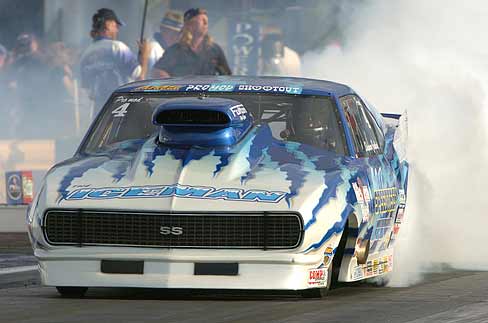|
IHRA Penalizes Supercharged
Pro Mods . . . Again
By Jeff Burk
4/29/04

 t
approximately 2:18 p.m. ET on April 29, 2004
the IHRA once again penalized the supercharged
contingent in Pro Modified and at the same time
gave the nitrous oxide-injected racers yet another
tool to allow their cars to be quicker and faster.
This writer, magazine and the supercharged Pro
Mod racers got sucker-punched at the same time. t
approximately 2:18 p.m. ET on April 29, 2004
the IHRA once again penalized the supercharged
contingent in Pro Modified and at the same time
gave the nitrous oxide-injected racers yet another
tool to allow their cars to be quicker and faster.
This writer, magazine and the supercharged Pro
Mod racers got sucker-punched at the same time.
Over the last several years the IHRA tech department has continually penalized the racers using supercharged engines. They have issued rules that made the cars weigh nearly 300 lbs more than the nitrous cars; frozen the cubic inch limit for supercharged cars at 526 cubic inches; restricted rear gear ratios, transmissions, and numbers of clutch discs; outlawed ignition improvements; and reduced supercharger overdrive several times from 32 percent over crankshaft speed to the just-announced 20 percent over crankshaft speed.
During that same time the nitrous oxide racers have basically been allowed to do whatever they wanted.
In the middle of the 2003 season, the IHRA rule makers again reduced the maximum over drive for blower equipped cars from 29 percent to 25 percent. At the same time they gave the nitrous oxide teams an additional 25 cubic inches increasing the cubic inch limit of their engines from 715 to 740.
The question an outside observer has to ask is why, after just two races into the 2003, did IHRA penalize their supercharged racers again? From the outside it appears that the cars seem fairly well matched. During the 2003 season nitrous cars regularly dipped into the six-teens with a best elapsed time of 6.155. The quickest lap for a supercharger-equipped car (with the 25-percent overdrive rule) was a 6.111. Both times were recorded at Rockingham Dragway at the last race of the 2003 season.
At the first race of the 2004 IHRA season at San Antonio, Texas, the Pro Mod racing couldn't have been closer. After the first round and into the finals there were exactly the same number of supercharged cars and nitrous oxide-assisted cars in the field. A nitrous car and a supercharged car met in the final round. The blown car won. At the second race, five nitrous cars made the field but only one advanced past the first round.
So, I suppose in some nonsensical way a case could have been made for tweaking
the rules to help the nitrous Pro Mod racers
but certainly not for issuing what could amount
to the death penalty for many of the supercharged
racers. What IHRA's tech department did was
to take 20 percent of the overdrive away from
the supercharged racers, reducing the maximum
overdrive from 25 percent to 20 percent, which
means the blower turns 20 percent slower than
it did. At the same time the nitrous cars were
approved to use the MSD 7531 ignition that has
the capability to function as a traction control
device. I talked to engine builders Jim Oddy,
Mike Janis and Darren Mayer who all also tune
supercharged Pro Modified cars and they were
all of the opinion that the overdrive rule would
immediately cost them a minimum of 200 horsepower.

|